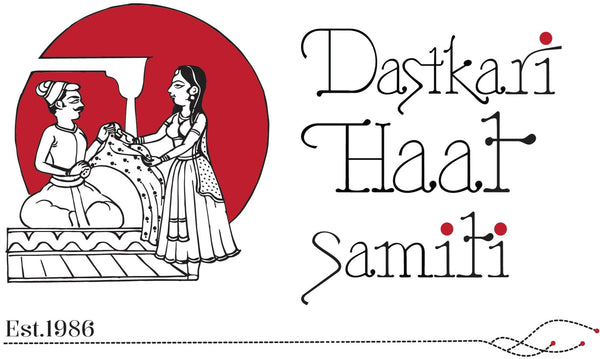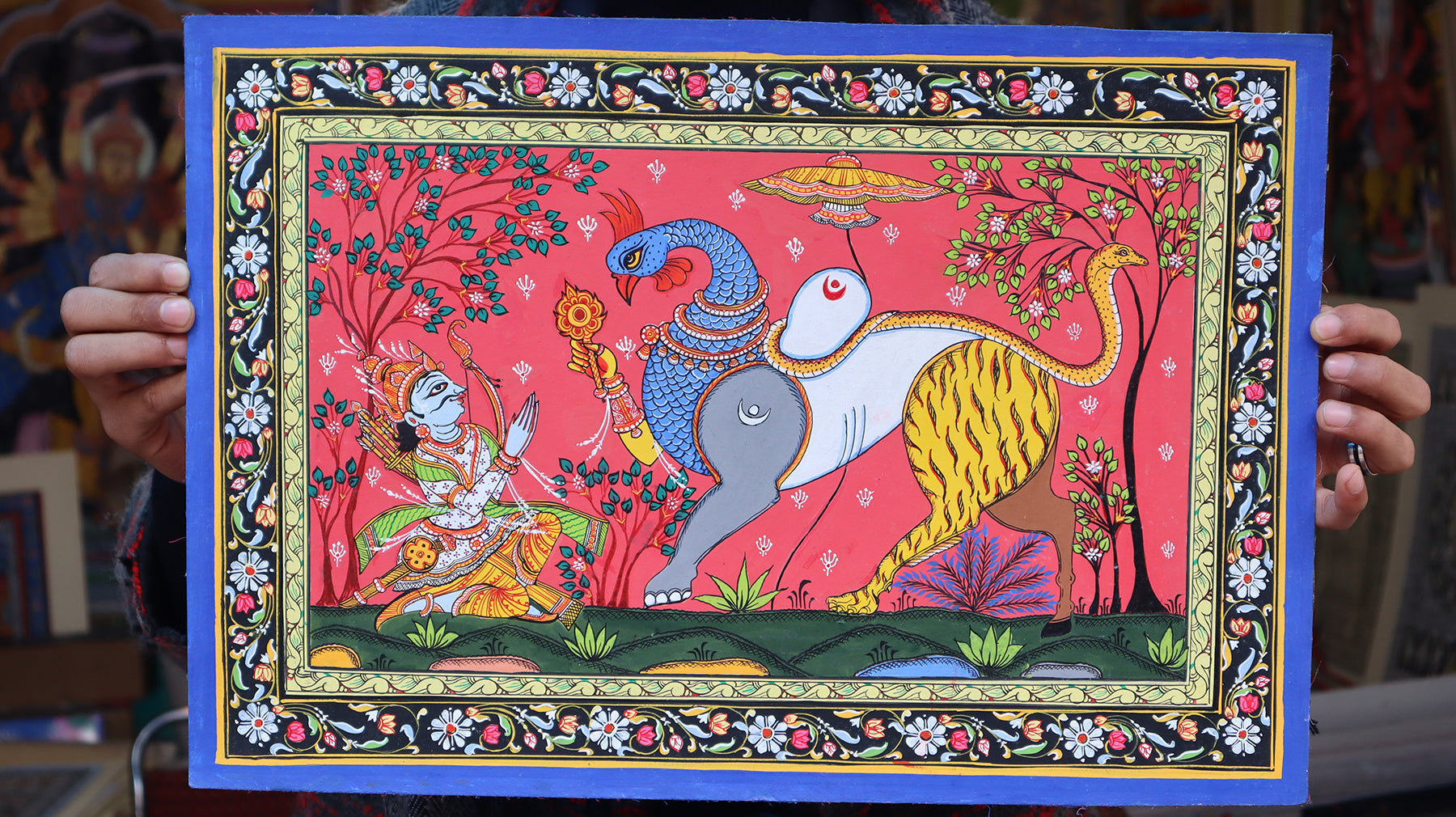Tracing Memories through the Tradition of Pattachitra
In his Aunt's quaint village, nestled amidst the verdant embrace of nature, young Rabinder found himself looking forward to the visits. Why wouldn’t he? When through the mundane rigmarole of schooling one finds joy in a kaleidoscope of colors and intricate painted narratives, each trip makes for a delightful anticipation.
In the hustle and bustle of Delhi Haat, one stall boasted exquisite Pattachitra artworks. The artist, Ravindra Behra, stood patiently witnessing a young crowd of visitors admiring his scroll artworks. As a young lad took to gingerly flipping the circular flaps of his Dashavtaar scroll painting, the others gasped in awe to see design inscribed on both sides of the flaps.

Rabinder Behra, Pattachitra Artist
In an age where Western influences hold sway over the aesthetic sensibilities of the youth, such a fervent engagement with traditional art is a sight both rare and precious. It is a testament to the enduring power of heritage amidst the relentless march of modernity. For Ravindra, each appreciative gaze cast upon his work is a validation of his lifelong dedication to Pattachitra, a source of profound joy that transcends mere recognition. In these fleeting moments, he finds solace and fulfillment, cherishing the affirmation of his artistic pursuit. Since his childhood, he knew it was Pattachitra where his ambition lay. It was for his pursuit that he gave up formal education.
“In my family, there was no tradition of practicing Pattachitra. It wasn't until I visited my aunt's village that I first encountered this art form. It was the artists who drew, and yet I felt joy at each brush stroke! School studies didn’t interest me and my rebellious soul needed an out.” he shared with a slight hint of a smile etched across his face, followed by a light chuckle.
“It was during an inter-school competition that my path became clear," he continued. “Among the contestants were myself and a close friend, with him securing the first runner-up position and myself, the second. I was on cloud nine! The prize given included typical childhood delights like chocolates, colors, and books - which served as a pivotal moment of motivation for me. It was then that my inclination towards art deepened, and a fervent desire to pursue Pattachitra was instilled within me. In that fleeting instant, I knew with unwavering certainty that this was my true calling.
As fate would have it, what needed to be done was done - seventh grade became the final chapter of my classroom musings, as I devoted myself to following my dream—to become a Pattachitra artist!”
On the southern banks of river Bhargavi, a dozen kilometers away from town Puri, lies the picturesque village of Raghurajpur. Nestled among groves of Palm and Coconut, it holds the distinction of being Orissa's first heritage crafts village. A major tourist destination of the state, it is known for its master Pattachitra painters and various other craft practices. Walk through its narrow lanes and you’ll find houses adorned with beautiful mural paintings. Serving as the cornerstone of Raghurajpur's artistic heritage is Dr. Jagannath Mahapatra, whose mastery of Pattachitra art has been pivotal in transforming the village into a sanctuary of creativity.
“I believe that having a mentor is essential in life, and I was fortunate to find mine early on. After leaving school, I sought the wisdom of Guruji Jagannath Mahapatra at his Gurukul. He wasn't just my first mentor; he was a guiding force for numerous aspiring Pattachitra artists, including myself. Today, nearly all Pattachitra artists have been taught by him. For nine years his teachings were my compass, guiding me through art and life until fate had its way and Guruji passed away.
I returned home but still felt a longing to learn more and further hone my skills. This led me to take solace in the tutelage of Guruji Dinabandhu Mohapatra, a revered figure in the annals of Pattachitra’s artistic heritage. Under the Guru-Shishya tradition of learning, he created more than a thousand artists. I feel humbled to be one of them.
Like any village dweller, I wished to travel to metro cities with the hopes and dreams of creating something big. After honing my skills, I set my journey to Dilli Haat, a hub of Indian crafts, with the hopes of contributing to it with my art. It was there that I met Jaya Ma’am, who, upon seeing my artworks, approved and admired them, granting them a place in her craft bazaar. That approval marked a significant milestone in my journey. Today, as people recognize and purchase my artwork, I feel there's no turning back, neither for me nor for my art.
Continuing the legacy, my son has taken an interest too. Little he is and yet is always trying to imitate my work in his playful way. If you visit our home, you'll see his artwork adorning the walls. I'm teaching him and his siblings our family craft.
It's like passing on the torch, you know? I dream of establishing a Gurukul in the future. The traditional ones are fading away with each passing day. I hope to carry forward our legacy and ensure it never fades into oblivion.”, Rabinder narrates passionately as he recounts his life up till the present moment.

Artwork by Rabinder depicting Lord Jagannath (Krishna) with siblings Balabhadra (Balram), and Subhadra
Having evolved into a widely cherished art form, Pattachitra finds its roots tracing back to Jagannath Ji. In ancient times, the practice of painting on walls was prevalent in temples and places of royalty. Similarly, Pattachitra finds its origins in the sacred precincts of temples, notably the Jagannath Temple. Initially, these paintings were exclusively created for the deity Jagannath but Over time, people began adorning the doors of their homes with Pattachitra paintings, especially during joyous occasions like weddings. Before the commencement of the Jagannath Ji Yatra, the deities undergo a ritualistic bath known as Snaan. Legend has it that after this bath, the deity catches a cold, necessitating their stay within the temple premises for either 15 or 30 days.
The traditional method of creating Pattachitra involves using two cotton sarees as a canvas, which are coated with a mixture of white chalk and tamarind seeds. Afterward, the painting is rubbed using two distinct stones, following which the cloth is allowed to dry. On this prepared canvas, depictions of Jagannath, Balabhadra, and Subhadra are meticulously drawn, mirroring their revered status in temples where they are worshiped as Subhadra, Anant Vasudev, and Anant Vasuki.
After a month-long display, the Pattachitra paintings undergo a ceremonial immersion, known as Visarjan, signifying the conclusion of their display. Delving more into it, Rabinder gives a detailed account of his art:
In ancient times, the Mohapatra bans and Maharana bans, respectively, carried on the art as a generational legacy. I entered this line driven by a genuine interest and inclination, marking the beginning of a new generation in my family. These bans specialized in creating paintings such as Jatri Patti. Whenever people gathered outside temples for worship, they would stand there, showcasing their paintings as a means of income. This tradition is akin to how we exhibit our work at Delhi Haat. Those who admired the paintings would give mudras (tokens) and purchase them, gradually elevating the status of Pattachitra as a viable source of income. This trend proliferated over time, leading to its present-day prominence.
Pattachitra (paṭṭa means "cloth" and chitra means "picture") encompasses two types of chitras: one on ‘Patta’ (cloth) and the other on ‘Patte’ (palm leaf), which was common in ancient times when pen and paper were not used. One can find these ancient manuscripts, such as the Ramayana and Mahabharata, in museums. The depiction of the Ramayana, for instance, would be done in a line or two, with visualizations accompanying the text on both sides of the leaf. This practice dates back thousands of years and involves intricate carving, known as ‘Patti Chitra’ since it is made on leaves.

Lord Ganesha & Dashavatara, i.e. The Ten Incarnations of Lord Vishnu
Originally, Pattachitra was created on single sheets, but over time, artists began stitching them together and drawing on them. While earlier works were not as precise and were made on larger surfaces, modern Pattachitra exhibits elaborate details, even on smaller surfaces. In the past, it was thick and less detailed, while modern ones are precise, neat, and clean, even on a surface as small as a nail. One can say that the specialty of Pattachitra lies in its precision and fine workmanship, with no margin for error. The paints are made from naturally available resources. For instance, sea shells are boiled to obtain white paint, while soot from a brass lid kept atop a lit lamp is used for black. In Patta paintings, bright colors like red, yellow, indigo, black, and white are predominantly used. The brushes utilized by these artists, known as 'Chitrakaras', are indigenous and made from the hair of domestic animals. Typically, a bunch of hair is tied to the end of a bamboo stick to create the brush.
As unique as this craft is, the stories it speaks of resonate with the audience, such as the bond between siblings, represented by Jagannath (Krishna), Balabhadra (Balram), and Subhadra. The paintings often adorn the walls of the Puri Jagannath Temple, the largest temple dedicated to Lord Jagannath.
They depict stories from Hindu mythology, such as the life of Krishna. One such painting made by Rabinder depicted the entire series of Krishna’s life story - from the marriage of Vasudev and Devki, his subsequent birth to triumph over the demon Kans, and other significant events - the entire series of Krishna’s life intricately illustrated. Another captivating painting, titled Kandarbh Haathi, depicted all the Gopis joining together in poses, forming an elephant for Krishna's ride. Dashavatar, the ten avatars of lord Vishnu also remains a pivotal theme in one of his paintings. Indigenous folklore often emphasizes the infinity of the universe.
In Mahabharat, when Arjuna while in exile with the other Pandavas, comes across a complex creature, in a state of confusion and bewilderment raises his bow aiming at it. Known as the Navagunjara, it comprises a peacock's head and neck, a bull's hump, and a serpent's tail. Its three legs include a tiger's and a deer's hind legs, and an elephant's left foreleg. The right foreleg holds a lotus in full bloom in the shape of a human hand. Upon realizing that Navagunjara is a manifestation of Lord Vishnu, Arjuna surrenders his weapons and bows to the creator, thus acknowledging the vastness of the universe and its diverse creations. The motif's roots lie in the folktales and legends of the Jagannath temple in Puri.

Navagunjara, a popular motif of Navagunjara
Rabinder's narrations vividly depict how a cultural craft becomes intrinsic to one's life, evolving from childhood passions into a legacy passed down through the ages. Life surely is unpredictable and more often than not comes around in a circle. Little did he know that paintings we witnessed being made when a youngster would become his passionate pursuit for the future. While our human tendencies entangle us in the complexities of life, the cosmic calling of the universe always shows the way. At times, it is through vivid experiences, guidance by loved ones—or the culture and tradition inherited—that we find our path.

